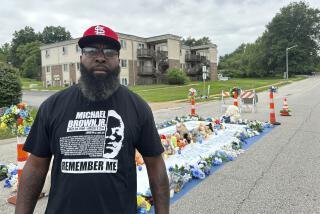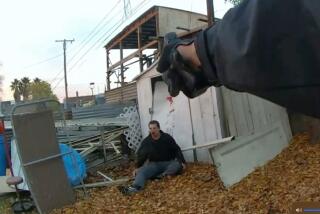Autopsy shows Michael Brown was shot six times, and twice in the head

A private autopsy on slain Missouri 18-year-old Michael Brown indicated that six bullets struck him, two of them in the head.
- Share via
Reporting from Ferguson, Mo. — Michael Brown was shot at least six times, including twice in the head, a preliminary private autopsy found, a Brown family attorney said Sunday night.
This mostly black St. Louis suburb has been racked by unrest since Brown was shot by a Ferguson police officer Aug. 9. More turmoil erupted hours before the midnight curfew was to take effect.
Protesters have marched every night since Brown, an 18-year-old unarmed black man, was killed by Ferguson police Officer Darren Wilson. Some demonstrations have been punctuated by looting, vandalism, tear gas and rubber bullets.
On Sunday, the Brown family received a diagram from the private autopsy performed by former New York City Medical Examiner Michael M. Baden, family attorney Anthony Gray said. The diagram showed six entry wounds, including two to the head, he said.
“It raises the same questions we had before,” he said, adding, “The bullet marks on the body are consistent with the witness statements.”
One of the wounds was on top of Brown’s head, Gray said.
“To have a shot that’s at a 90-degree angle from the top of his skull to the bottom of his chin, almost vertical, that sounds like an officer standing over him,” he said.
Baden said his examination suggested that none of the six bullets was fired at point-blank range, but all were fired from at least one to two feet away.
“There’s no evidence of powder residue,” Baden said in a telephone interview with the Los Angeles Times.
Baden said two bullets struck Brown in the head: one in the forehead and one at the top of the head — fired at “a right angle to the top of the head.”
“The top of the head one was the one that would have made him unconscious and fall to the ground,” Baden said.
But it is difficult to draw firm conclusions from that, he said, without also considering witness statements and marks on Brown’s clothing. “The head is very movable, and it can be in a number of positions,” he said.
At least one of the wounds to Brown’s arm “could have been defensive,” Baden said.
The autopsy results were first reported by the New York Times.
Police say Brown had participated in a strong-arm robbery at a mini-mart shortly before his encounter with the Ferguson officer.
At least one witness who was accompanying Brown that afternoon has said Brown was shot as he walked away from the police officer with his hands raised, and then was hit with additional bullets.
Also Sunday, U.S. Atty. Gen. Eric H. Holder Jr. instructed the Justice Department to have a federal medical examiner perform an autopsy on Brown, citing “extraordinary circumstances” and the family’s request. It will be the third autopsy in the case, counting the local official one.
Holder’s decision is the latest development showing that federal investigators are conducting a far different inquiry than local officials. Federal authorities are reviewing the shooting to determine whether there were any civil rights violations, while local officials said they were trying to determine whether the officer was justified in using lethal force.
More than 1,300 participants filled Greater Grace Church and spilled out the door for an afternoon rally hosted Sunday by Brown’s family, Al Sharpton’s National Action Network and the National Bar Assn.
Sharpton urged the community to take positive action, and to vote. “Don’t loot in Michael’s name,” he implored. He added, “You all got to start voting and showing up — 12% turnout is an insult to your children.”
Among those who spoke was Missouri State Highway Patrol Capt. Ronald Johnson, who took charge of the police response to protests late last week at Gov. Jay Nixon’s direction.
Johnson, appearing in uniform, told the crowd that he had met Saturday with some of Brown’s relatives.
“They brought tears to my eyes and shame to my heart,” Johnson said. “I wear this uniform. And I should stand up here and say I’m sorry.”
On Sunday, as protesters returned to the streets, the St. Louis County Police Department tweeted about 9:15 p.m.: “Molotov cocktails [were] being thrown at police. Tactical units on the scene. Please leave the area!”
Authorities said gunshots had been reported in the central demonstration area and warned people to clear the streets.
Protesters were marching peacefully, holding their hands in the air and chanting, “Hands up, don’t shoot.”
Overnight Saturday and into Sunday, protests broke out as police sought to enforce the curfew imposed to quell unrest. An unidentified male was in critical condition after being shot.
Missouri State Highway Patrol Sgt. Al Nothum said the wounded man was a protester shot by a fellow protester. The motive was unclear, he said, adding, “We don’t know if it was intentional or not.” The victim was driven to a hospital in critical condition, he said.
Seven people were arrested in connection with the Saturday clashes, all for failure to disperse, he said.
Nothum said Johnson “made it real clear that we will use any force necessary.”
Saturday was the quietest in nearly a week, with no reports of looting, Nothum said. “Last night was one of the best evenings that we had even though it was quite hectic.”
On Sunday night, some protesters were astonished at the police response.
“It’s unbelievable. This is something you would see on TV in a third-world country,” said Martin McDonald, 38, a truck driver from Florissant who had joined the crowd for the first time Sunday. “Tear gas — I’ve never seen it escalate to that point.”
Hennessy-Fiske reported from Ferguson and Serrano from Washington. Times staff writers Kim Murphy, Matt Hansen, Lauren Raab and Kurtis Lee in Los Angeles contributed to this report.
More to Read
Sign up for Essential California
The most important California stories and recommendations in your inbox every morning.
You may occasionally receive promotional content from the Los Angeles Times.















